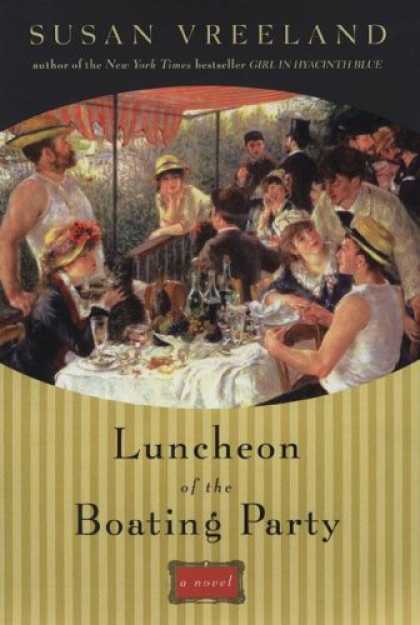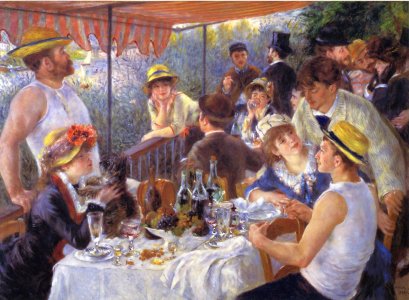And technically, I guess I shouldn't have said that, especially as a nominal member of the history department at my high school (I teach one class each trimester). And I suppose I should show some support for the curriculum I teach. And I suppose they may take my words too far to heart and begin refusing to read their assignments.
But if they pause to consider the intent of my startling announcement, they will know what I meant. And it is this: history, when read only in a textbook, IS dry and boring and will make even someone who loves the subject begin to weep in abject misery. (Maybe a little too harsh, still.)
Okay, here's what I really wanted them to discern: history can be positively FUN to learn if discovered in other ways. How about that? I don't think my department chair would eviscerate me for saying that.
Case in point: the book Luncheon of the Boating Party by Susan Vreeland. I was drawn to the book for a)its cover and b)a recommendation from Sarah. Together, these resulted in a sale (and it didn't hurt that the hardcover had been discounted to FIVE NINTETY-NINE!). Just look at this! Wouldn't you want to buy it, too?

If you love art or history--or just a good story--you should read this book. It's also a great read for those who love FOOD. Yes, ladies, I said the magic word. It didn't create a craving for French food quite like Chocolat did, but it came a close second. Susan Vreeland uses a wealth of research and period detail to recreate Paris in 1880, when Impressionism was at its height and the modern world was beginning to make its presence known with things like factories along the Seine and a precursor to the Harley called a steam cycle.
Pierre-Auguste Renoir loves to paint because he falls in love with what he paints. Usually, this is women, and he has loved many. As I read the book, I found myself rooting for Alphonsine, a widow of the Franco-Prussian War, who lives and works at Maison Fournaise, which her father owns. It is a restaurant along the Seine, just outside Paris, a place where Parisians come to relax and celebrate the weekends.
Together, Alphonsine and Auguste envision the idea of a painting of the terrace of her family's restaurant with a view of the river. It is Auguste who decides to make it so large, to include so many models, to mix Impressionism and Realism. This is the result:

You can see Alphonsine in the back, leaning on the rail. When I study the painting, my eye is drawn to her. Maybe because I like her best. Alphonsine tells Auguste one day about Alexander, a Russian engineer, who designed repairs to the bridge you can see in the background of the painting. Alexander had a dream of building an iron tower, its framework just like a bridge, that stretched into the sky. Sadly, he died before his dreams could be realized. Do you know what that tower was? Think about it. Yeah, you're right. Good job.
And another thing I loved about this book--which I had never stopped to consider, was how brim-full Paris was of artistic life in the 1880s. After I read the novel, I pulled down my massive HISTORY OF ART picture book, and almost all the artists of the Impressionist period in my picture book had made guest appearances in the novel. How cool is that, to think that while the characters were wandering the streets of Paris, they brushed shoulders with Degas, Sisley, Cezanne (well, talked about him), and of course, Renoir. The novel also is peopled with writers and musicians of the time. Apparently, Paris was the place to BE. (Maybe I should re-set my time machine, eh? How fascinating would Medieval England be, compared to this. Plus, the food. I don't think I'd like suet pudding and eels much.)
The only thing I didn't like about the book--and I don't know how Vreeland could have avoided this--is the abundance of important characters. The book traces the stories of each of the figures in the painting, showing how they knew each other, how they were connected. And it's all pretty accurate, as I learned when reading the Author's Note. So anyway, I could keep the principals straight, but not the others. It took me at least half of the book to figure out who was who. I seriously considered writing the names of the characters above their figures in the painting...OH! Did I mention that the hardcover has four full color pages with seven of Renoir's paintings on them? Yeah, I know. Seriously cool. How many other books have I read about artists where I end up sitting in front of the computer looking up one painting after another? Right.
Well, I ended up figuring out who was who around page 213, and from there on out, it was all good. I read a few reviews that chide Susan Vreeland for getting too deep into her research and including too much of it in the novel. It was a little chewy at times, but I like that. After all, it's my favorite way to learn history.
So, I'm curious: which figure is your eye drawn to first? Tell me...and then read the book.

5 comments:
The lady in the background leaning on the railing with her head in her hands caught my eye first! And I have to agree with you...textbooks make learning any subject so very dull! History is interesting and can be learned easily and enjoyably if in the right medium. I know some movies are a little off on their facts of historic events and maybe a few books too - but anything that brings the subject matter to life is better than being bored to death!
I'm most drawn (like Stacy) to the lady leaning on the railing.
Side not: the man leaning on the chairs resembles Harry Connick, Jr. in my opinion. Maybe because I've been listening to his Christmas music so much lately. :)
Now I'm curious what you know about these characters - guess I'll have to read it & find out.
*note
I just read The Girl in Hyacinth Blue, same author, could not put it down-did you get the book at the library? I would like to ead it. The one I read was excellant!
Appreciate you bloogging this
Post a Comment